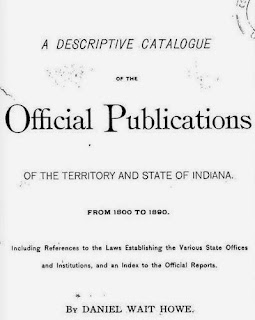Quietly, the Kane County, Illinois, Recorder's office has placed all of its deeds (and several other kinds of documents) on line. Basically this is good news but there are a few qualifiers as described in the following quickie tutorial:
(1) Few genealogists will be using the tab that says "Search Land Records" --the straightforward grantee and grantor search only works for deeds since 1980. The interface for older deeds is somewhat klunky, but structurally it's
the same that we go through in person: first find promising entries in
the grantee and grantor indexes, then find the deeds themselves in the
deed books.
(2) The grantee and grantor indexes are reached by going to the tab "View Miscellaneous Documents," then "All Miscellaneous Documents," and then choosing "Grantee Index" (actually a whole bunch of volumes of grantee indexes) or "Grantor Index" from the resulting menu. Under "Grantee Index" there's a list of books identified by volume number and year. Pick your book and then pay attention to the, um, unique patented method that a previous recorder chose to use for indexing. (It's called "Dennick's Universal Chart System of Indexing, patented in 1893, and explained below ** as it will take a while.)
(3) Once you've found a book and page number to consult in the deed books themselves, go back to the beginning and hit the tab "Books," under that "Document Books," under that "Folders" (actually original deed books), pick the desired volume number, and then within that volume the page.
(4) Once you're there, the images are variable in quality, with many portions of pages overexposed. (In some cases you may want to transcribe from the image rather than print it out.) Many pages are missing at least one line at the bottom. I have usually found FamilySearch's deed images from other states to be of better quality.
All this said, this degree of online access is better to have than not to have. Kane County is a suburban county west of Chicago, and I'm in a suburban county southeast of Chicago. Even living that close it's cheaper to work the deeds this way than in person. And the more people who can use this option, the better the old deeds are saved from extra handling.
** The grantee and grantor indexes are each arranged under one of many supposed 19th-century improvements on the alphabetical-by-first-letter-of-surname-and-then-chronological default system. First, surnames are organized in the following 47 initial-letter-equivalent groups, each beginning with a certain number, as follows:
A 1, Ba 14, Be 27, Br 40, B 53, Ca 66, Co 79, C 92, D 105, E 118, F 131, Gr 144, G 157, Ha 170, Ho 183, H 196, I 209, J 210, K 223, L 236, Ma 249, Mo 262, M 275, Mc 288, N 301, O 314, P 327, Q 340, Ro 341, R 354, Sc 367, Sh 380, Sm 393, St 406, S 419, T 432, U 445, Va 446, Ve 447, V 448, Wa 449, Wh 462, Wi 475, W 488, Young 501, Y 502, Z 503.
Within each surname initial-letter-equivalent, given names are organized according to 13 different initial letter equivalent groups: AB, C, DE, FG, HI, Ja, Jo, J, KL, MN, OPQR, STUV, and WXYZ.
Note that in this system surnames are not in alphabetical order: Grommet will appear ahead of Garofalo because their initial-letter-equivalent groups are in that order. And within each surname letter-equivalent-group, the names are organized by given names.
I looked for Levi Goodrich in the earliest grantee index, beginning in 1837. Since his surname starts with G (page 157), given names beginning with "L" will be found at the ninth given-name initial letter equivalent group, so 165. (One big advantage of Kane County's system is that its image numbers correspond to the original page numbers, at least where I looked.) On 165 I found an L. D. Goodrich buying property, referring to a deed at volume 35, page 511. Before going to the deed, I carefully scrolled to the bottom of the page and found that this listing was continued on page 130, where I checked for any more.
OK, he turned out to be Lewis D. Goodrich, not Levi, but those are the breaks. Good luck and good hunting!
Note: As I have learned from Michael Hait's on-line state resources book, DeKalb County has what appears to be a similar setup (in beta test and requiring login) which I have not examined in detail.
Harold Henderson, "Pretty good news for Kane County, Illinois, land researchers," Midwestern Microhistory: A Genealogy Blog, posted 23 December 2013 (http://midwesternmicrohistory.blogspot.com : viewed [date]). [Please feel free to link to the specific post if you prefer.]























